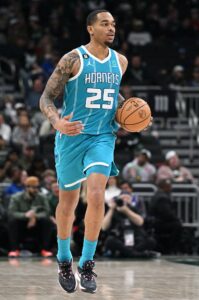The schedule for the NBA’s 2023/24 season released on Thursday, giving fans plenty to look forward to beginning in the fall. From the number of nationally televised games to the league debuts of several players, there’s no shortage of storylines to track this coming season.
As always, there are a number of reunions to keep an eye on. Bradley Beal makes his return to Washington on Feb. 4. Kevin Durant, who won two rings with the Warriors in 2017 and 2018, plays in Golden State in front of fans on Oct. 24 for the first time since leaving in 2019. Jordan Poole returns to Golden State on Dec. 22. Chris Paul plays in Phoenix on Nov. 22 for the first time since joining the Warriors. Fred VanVleet plays against Toronto for the first time on Feb. 9.
Outside of returns to previous stomping grounds, there are also several matchups of note. A 2023 NBA Finals rematch between the Heat and Nuggets is scheduled for Feb. 29 in Denver.
The showdown between the No. 1 and No. 2 picks in each year’s draft class is always a date to circle. However, a 2022 offseason foot injury to Chet Holmgren prevented fans from seeing Holmgren, the No. 2 pick in the 2022 draft square off against Paolo Banchero, the No. 1 overall selection in the same class who went on to win Rookie of the Year. Now fully healthy, the pair is set to face one another on Feb. 13 in Orlando.
The top of this year’s draft is equally intriguing. While there was no denying Victor Wembanyama would go No. 1 overall, plenty of debate ensued regarding the No. 2 selection. Brandon Miller ended up going second overall to the Hornets, while Scoot Henderson went third to the Trail Blazers. The careers of all three players will be followed with great interest.
Wembanyama squares off against Miller for the first time on Jan. 12. Miller plays Henderson for the first time on Feb. 25. Henderson, who previously played against Wembanyama in an October G League showcase, plays the French big man for the first time in the NBA on Dec. 28.
Outside of that, the Christmas Day games and opening night games appear to be as stacked as ever, with nearly every contender getting a primetime appearance.
It also seems as though the NBA is actively attempting to hand out more rest days to its stars. The biggest issue teams and players alike had with previous schedules is the amount of back-to-back games on a team’s schedule. According to BasketballNews.com’s Alex Kennedy (Twitter link), the team average for road back-to-back games this season is down to 9.0, a record low, down from a then-record low 9.6 back-to-back games last year.
This leads us to our question of the day. What aspect of the ’23/24 schedule excites you the most? Who are you most excited to see make their NBA debut? What is going to be the most exciting matchup? Were any teams snubbed from nationally televised games? Are you planning on attending any specific games?
Please take to the comments section to weigh in on this topic. We look forward to your input.


 As our
As our  Trent Forrest
Trent Forrest